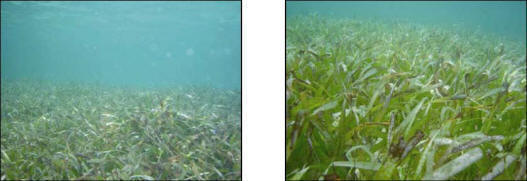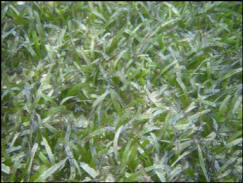|
|
|
|
|
|
|
| Seagrass Beds: An Underwater Rainforest | ||
|
The view from the cliff’s edge overlooking Little Bay in north-central Anguilla gives you a bit of a rush – especially if you are nervous about heights. It is definitely a long way down to the secluded white sand beach. At the same time, you cannot help but look and be mesmerised; it is intoxicating. From even almost sixty feet up, green sea turtles can be seen skimming the underwater cliff line. The blue-green water shimmers even when the sky is overcast. Tropicbirds, pelicans, and the odd green heron can also be seen flying through the air or searching for their next meal. While the scene above the water is awe-inspiring, it is nothing compared to what is happening under its rippling surface. Schools of jacks create clouds as they swim in unison. Bright pink sea fans sway back and forth with the ebb and flow of the waves. Elegant eagle rays glide effortless above the sea bottom. A range of corals – looking like inanimate rocks to the casual observer – are actually breathing, eating, and living. And there is even an underwater field of grass – seagrass, that is. Seagrass are types of plants. They have evolved from those found on the land and even though they are specialised to live completely submerged in water, they still have leaves, roots, flowers, and seeds. Seagrass are also able to make their own food through a process called photosynthesis (the use of light energy to convert carbon dioxide and water into chemical energy) – the same way plants on land do. This means that seagrass beds are taking carbon out of the air which reduces the amount of a greenhouse gas in the atmosphere and which, in turn, also helps to control climate change. Seagrass beds are part of an integrated coastal zone system that is common throughout the Caribbean and the tropics. This complex system, in addition to seagrass beds, also includes coral reefs and mangrove forests. Together, they work to keep the vibrant coastal ecosystem functioning. Seagrass beds are particularly important to Anguilla because of the limited extent of the island’s mangrove forests. Mangroves tend to act as nursery grounds for inshore fish and as habitat for crabs and other invertebrates. But there are not that many coastal mangrove stands in Anguilla, and instead, seagrass beds have assumed this very important role. Seagrass beds have been described as “rainforests of the oceans” because of their complexity, the diversity of organisms that are associated with them, and their productivity. Seagrass communities are so productive, in fact, that only one acre can produce up to 10 tonnes of leaves per year, support up to 40 000 fish, and 50 million small invertebrates. They also provide habitat and grazing areas for some of the world’s most endangered species – the green sea turtle, the dugong, and the manatee. It is because of such diversity and the seagrass’ sensitivity to changes in the surrounding water that they are also considered to be important indicator species of the general health of coastal ecosystems. That is, the health of the coastal zone can be measured by the health of its seagrass beds.
And healthy seagrass beds are undoubtedly important for healthy fish
populations. Seagrass beds provide food, shelter, and nursery areas for
commercial and recreational fish species and for a wide range of invertebrates.
The beds act as a nursery ground when the leaves of the seagrass are relatively
dense – juvenile fish, along with small finfish and other invertebrates (such as
crabs) hide within the leaves, seeking protection from hungry predators and from
strong currents. Their extensive network of roots that run under the sea bottom
also prevents predators from digging too deep and from preying on organisms that
bury themselves in the sandy ground. At the same time, the roots also prevent
erosion of the sea bottom by keeping the sand compact and in place.
Clearly, the healthier and the more extensive the seagrass bed, the more fish and invertebrates can be supported (especially in their younger stages) and, in turn, the more fish and invertebrates are available for sustainable levels of harvesting. Algae also grow within the seagrass bed. One particular type of algae, called Halimeda, is hard and crusty because of its carbonate skeleton (similar to corals). When it gets broken or when it dies, wave action breaks down its hard body. After time, it becomes another source of the white sand that washes up on Anguilla’s expansive beaches. Unfortunately, despite the importance of these areas, seagrass habitats are under threat in Anguilla. While the most common type of seagrass found in the waters around the island is turtlegrass (Thalassia testudinum), coastal mapping and anecdotal evidence indicate that over the last ten or so years, the total area of seabed covered by seagrass has declined dramatically. What has led to this disturbing trend? Seagrass beds are sensitive habitats and can be affected by both natural and human-related (anthropogenic) stressors. Since seagrass needs light to photosynthesise and to grown, clear water that allows light to penetrate deeply into the water is a necessity. Water clarity is affected by stormwater runoff since after heavy rains, dirt and other substrates are washed into the ocean. If it is not too much, the seagrass is able to deal with the material by filtering the silt and sediment and then by incorporating it into the seafloor by trapping it with its roots. But when there is too much sediment, the seagrass beds become overwhelmed; they cannot capture all of the dirt and the sunlight cannot make it to the seafloor. In extreme cases, the sediment actually smothers and suffocates the seagrass, causing it to die. Stormwater and grey water runoff along with sewage outflow also carries chemicals, fertilisers, and other nutrient pollutants. Since seagrass are able to make their own food, they do not need extra nutrients in the water – if fact, too many nutrients are dangerous. Nutrients in the water cause phytoplankton and algae to grow. While there are usually some nutrients in the water column, in proper functioning systems, they occur at manageable levels. But when the levels get too high, algae will begin to grow uncontrollably on the seagrass and smother it. Entire seagrass beds can be destroyed because of excess nutrients. More direct anthropogenic impacts include the actual dredging of the seafloor (for example, for the creation of marinas). Dredging does not only physically remove seagrass but it also stirs up sand and substrate, once again increasing the chance that seagrass will be covered and suffocated. It could also lead to changes in water current direction and/or velocity which could further threaten them. Anchoring and the grounding of boats in seagrass beds are also extremely destructive since boat engine propellers can chew off the leaves and destroy the roots and anchors and boat bottoms can pull seagrass from the seabed. This leads to fragmentation of the habitat and the effects are especially damaging when the bed is already sparse. Fragmented seagrass beds are more vulnerable to the effects of erosion and to suffocation by loose sand since the sand is not being held in place by a root network. Of course, seagrass beds in Anguilla and around the Caribbean are also affected by natural stressors such as hurricanes and other strong storms that move sand onto them or by over-foraging by sea urchins and other marine organisms, by disturbance of leaves and roots by marine predators looking for prey within the beds, and even by disease. But the fact remains that seagrass beds around Anguilla used to be more extensive despite the storms and the other natural pressures on them; they seemed to be able to recover. They, however, have become especially vulnerable with the increase in the level of coastal development and of human activities and usage within these habitats – particularly over the last twenty or so years. So what does this mean for Anguilla? One of the most profound effects may be felt at the fisheries level. With the loss of seagrass beds around the island, comes a loss of nursery and foraging grounds for important commercial fish species such as lobster, conch, snappers, and groupers. Less habitat available for the fish means less fish found around the island and less available for harvesting. In 1993, the Government of Anguilla declared Little Bay a Marine Park. While the site is open for public use, certain activities are not allowed and other are supposed to be managed so that one of the island’s most extensive seagrass beds can be protected. But because of the nature of the marine environment – it is fluid and there are no clear boundaries – activities occurring outside of the Park are affecting what is happening inside of it. To compound the problem, some users of the area disregard the rules (such as no anchoring in the seagrass bed). There is still a seagrass bed in Little Bay, but it is a degraded one. It is not as healthy as it used to be and this is a disturbing sign. If a seagrass bed in a marine park is being damaged, what is happening to the other seagrass areas that are not protected? Because the ocean is a dynamic environment, it is difficult to manage small areas in isolation. Rather, a more comprehensive approach is needed. An integrated coastal zone management plan that considers the entire coastal area of the island, the people who use this important environment, the activities that take place within it, and the natural and anthropogenic stressors (both on the land and in the water) that are affecting it would not only be more appropriate, but also more effective. The development and implementation of such a plan is a process and requires understanding, cooperation, and transparency. Given the number of stakeholders who depend on and use the coastal zone, it will also undoubtedly be contentious and time-consuming. But it is necessary and the long-term benefits will far outweigh any short-term difficulties. Note: This article is supported by information provided by The Smithsonian Marine Station at Fort Pierce. More details on seagrass habitats can be found at their website at: http://www.sms.si.edu/IRLspec/Seagrass_Habitat.htm.
A seagrass bed in Forest Bay. Anguilla’s seagrass beds provide critical habitat for the island’s commercial fish species. They are being increasingly threatened by pressures occurring both on the land and in the water. Photos by S. Wynne, April 2007. Eco-Corner is written by Farah Mukhida . The Anguilla National Trust welcomes questions, comments, and at axanat@anguillanet.com. Together we can make a difference. Preservation for Generations. |

